Evaluation of Standing-Up Motion from a Forward-Sloping Toilet Seat for Older People
Abstract
1. Introduction
2. Materials and Methods
2.1. Participants
2.2. Measurement Items
2.3. Protocols
2.4. Data Analysis
3. Results
3.1. Motion
3.2. COP
3.3. EMG
3.4. Perceived Ease of the Standing-Up Motion
4. Discussion
4.1. Effect of Toilet Seat Angle on the Standing-Up Motion
4.2. Effect of Age on Toilet Seat Angle during the Standing-Up Motion
4.3. Limitation of This Study
5. Conclusions
- Older participants showed a consistent pattern of head motion and upper extremity movement strategies during the standing-up motion.
- The perceived ease of the standing-up motion is not always explained using objective data alone. For the same subjective comfort level, measured objective data exhibited considerable variations across individuals.
- Base on the subjective data, all participants found it easy to stand when the seat angle was 5° or 10°. Objective data on ankle dorsiflexion angle, muscle activity, and head movement may be related to the ease of the standing-up motion.
Author Contributions
Funding
Institutional Review Board Statement
Informed Consent Statement
Data Availability Statement
Acknowledgments
Conflicts of Interest
References
- Hignett, S.; Wolf, L.D. Reducing inpatient falls: Human Factors & Ergonomics offers a novel solution by designing safety from the patients’ perspective. Int. J. Nurs. Stud. 2016, 59, A1–A3. [Google Scholar] [CrossRef]
- Rosenberg, H. Epidemiologic and methodologic problems in determining nutritional status of older. Am. J. Clin. Nutr. 1989, 50, 1231–1233. [Google Scholar] [CrossRef]
- Stevens, J.A.; Haas, E.N.; Haileyesus, T. Nonfatal bathroom injuries among persons aged ≥ 15 years—United States, 2008. J. Saf. Res. 2011, 42, 311–315. [Google Scholar] [CrossRef]
- Nagai, S.; Yokoyama, Y.; Tokioka, T. A clinical study of inpatients suffering fall accidents. Jap. J. Occup. Med. Trauma 2004, 53, 88–91. (In Japanese) [Google Scholar]
- Centers for Disease Control and Prevention (CDC). Important Facts about Falls. 2017. Available online: https://www.cdc.gov/homeandrecreationalsafety/falls/adultfalls.html (accessed on 5 June 2020).
- Florence, C.S.; Bergen, G.; Atherly, A.; Burns, E.; Stevens, J.; Drake, C. Medical Costs of Fatal and Nonfatal Falls in Older Adults. J. Am. Geriatr. Soc. 2018, 66, 693–698. [Google Scholar] [CrossRef] [PubMed]
- Janssen, W.G.M.; Bussmann, H.B.J.; Stam, H.J. Determinants of the Sit-to-Stand Movement: A Review. Phys. Ther. 2002, 82, 866–879. [Google Scholar] [CrossRef] [PubMed]
- Mastalerz, A.; Palczewska, I. The influence of trunk inclination on muscle activity during sitting on forward inclined seats. Acta Bioeng. Biomech. 2010, 12, 19–24. [Google Scholar] [PubMed]
- Maruta, K. The influence of seat angle on forward trunk inclination during sit-to-stand. Phys. Ther. Jap. 2008, 31, 21–28. (In Japanese) [Google Scholar]
- Gross, M.; Stevenson, P.; Charette, S.; Pyka, G.; Marcus, R. Effect of muscle strength and movement speed on the biomechanics of rising from a chair in healthy elderly and young women. Gait Posture 1998, 8, 175–185. [Google Scholar] [CrossRef]
- Lord, S.R.; Murray, S.M.; Chapman, K.; Munro, B.; Tiedemann, A. Sit-to-Stand Performance Depends on Sensation, Speed, Balance, and Psychological Status in Addition to Strength in Older People. J. Gerontol. Ser. A Biol. Sci. Med. Sci. 2002, 57, M539–M543. [Google Scholar] [CrossRef] [PubMed]
- Otis, M.J.-D.; Adjelane, A.; Jomphe, E.; Youssef, K. Toilet Assistive System Designed for the Reduction of Accidental Falls in the Bathroom Using Admittance Controller. Machines 2017, 5, 23. [Google Scholar] [CrossRef]
- Ino, S.; Chikai, M.; Ozawa, E.; Endo, H. An Ergonomic Evaluation of Physical and Mental Loads in Standing-up Motion from Forward-Sloping Toilet Seats. In Proceedings of World Congress on Medical Physics and Biomedical Engineering; Springer: Singapore, 2018; Volume 68, pp. 15–19. [Google Scholar]
- Tatewaki, T.; Kaneko, S. A study of control mechanism for of standing-up achieving a motion task; biomechanical motion analysis of standing-up. Rigakuryoho Kagaku 2005, 20, 303–307. (In Japanese) [Google Scholar] [CrossRef][Green Version]
- Roy, G.; Nadeau, S.; Gravel, D.; Malouin, F.; McFadyen, B.J.; Piotte, F. The effect of foot position and chair height on the asymmetry of vertical forces during sit-to-stand and stand-to-sit tasks in individuals with hemiparesis. Clin. Biomech. 2006, 21, 585–593. [Google Scholar] [CrossRef] [PubMed]
- Millington, P.J.; Myklebust, B.M.; Shambes, G.M. Biomechanical analysis of the sit-to-stand motion in elderly persons. Arch. Phys. Med. Rehabil. 1992, 73, 609–617. [Google Scholar] [PubMed]
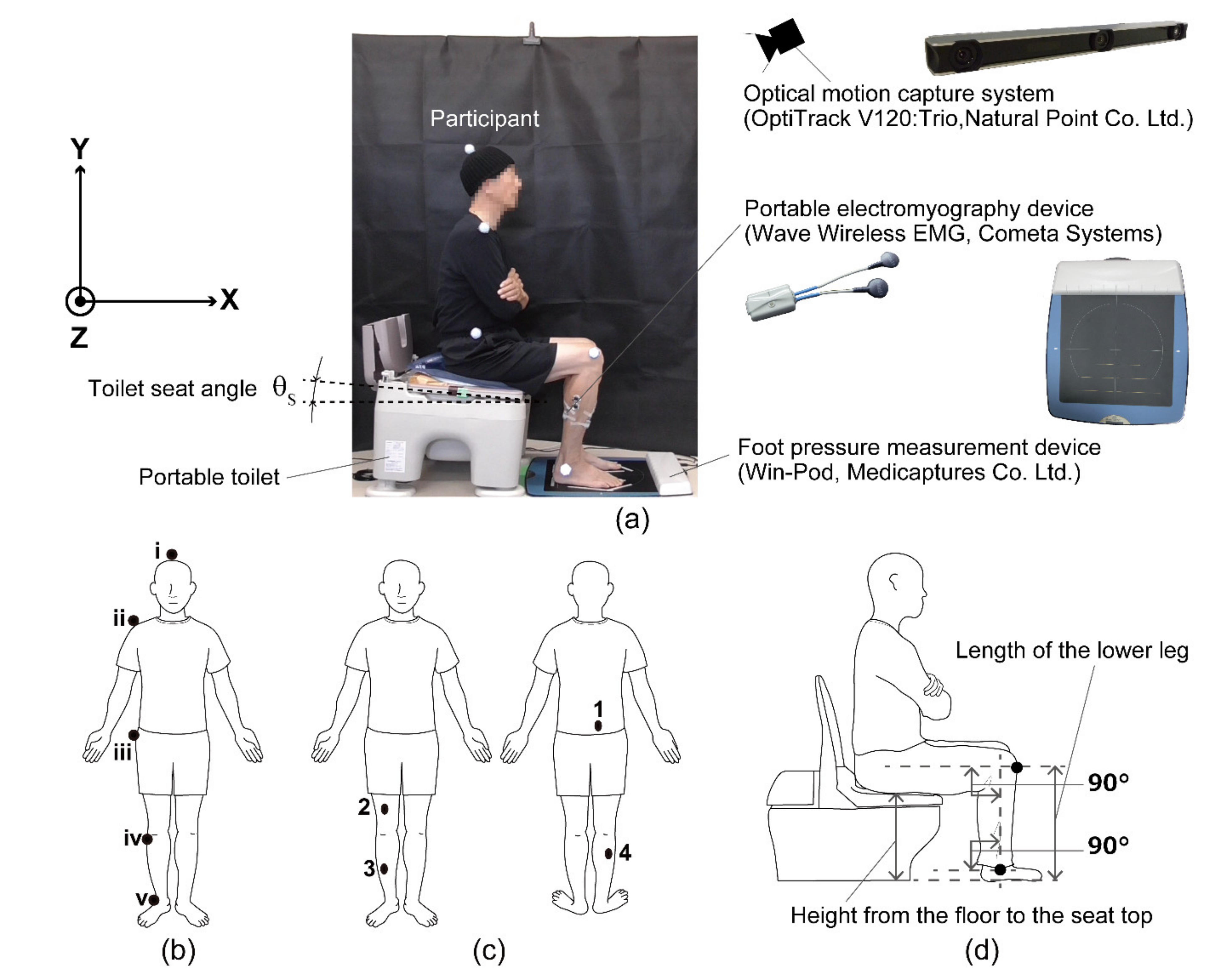

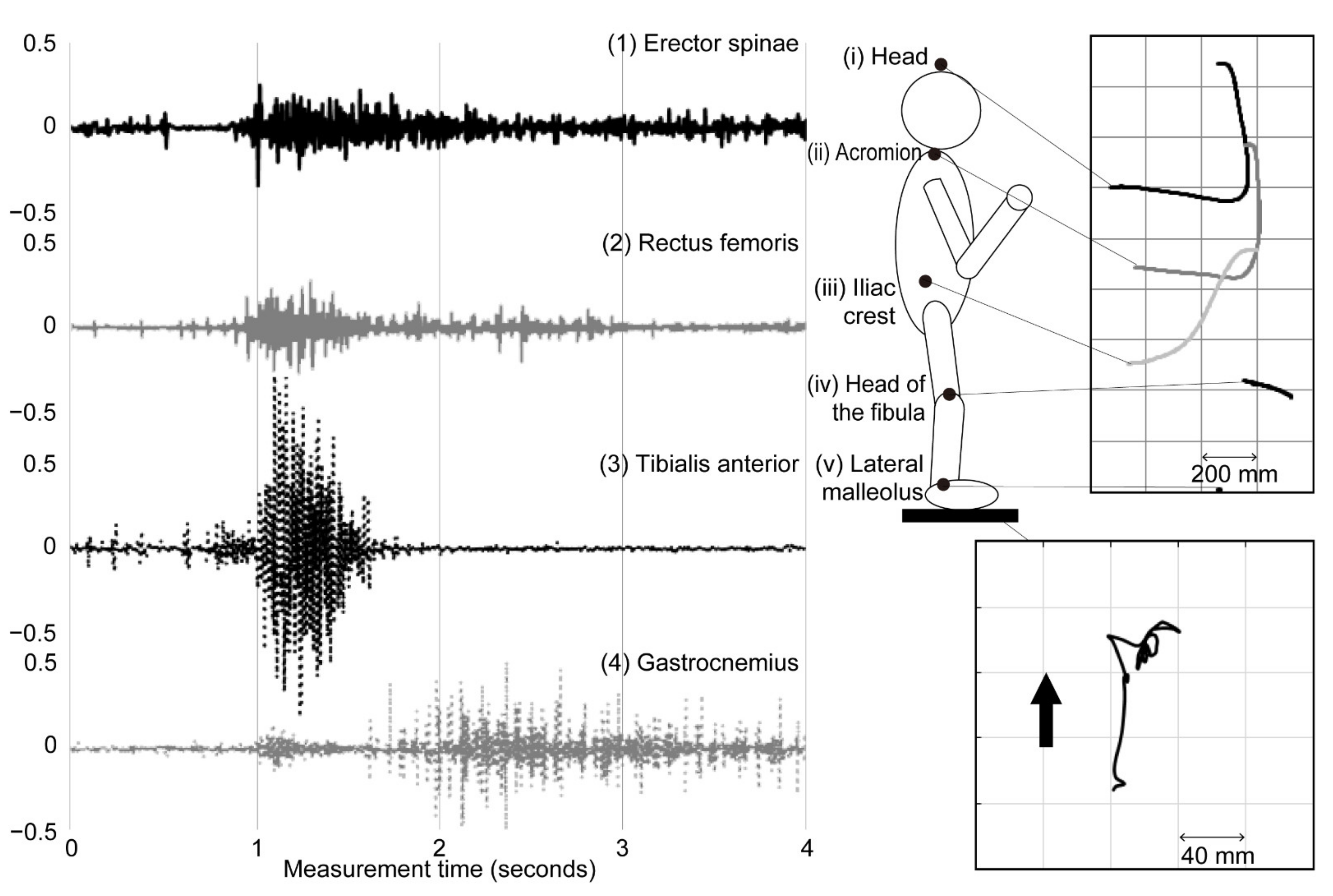
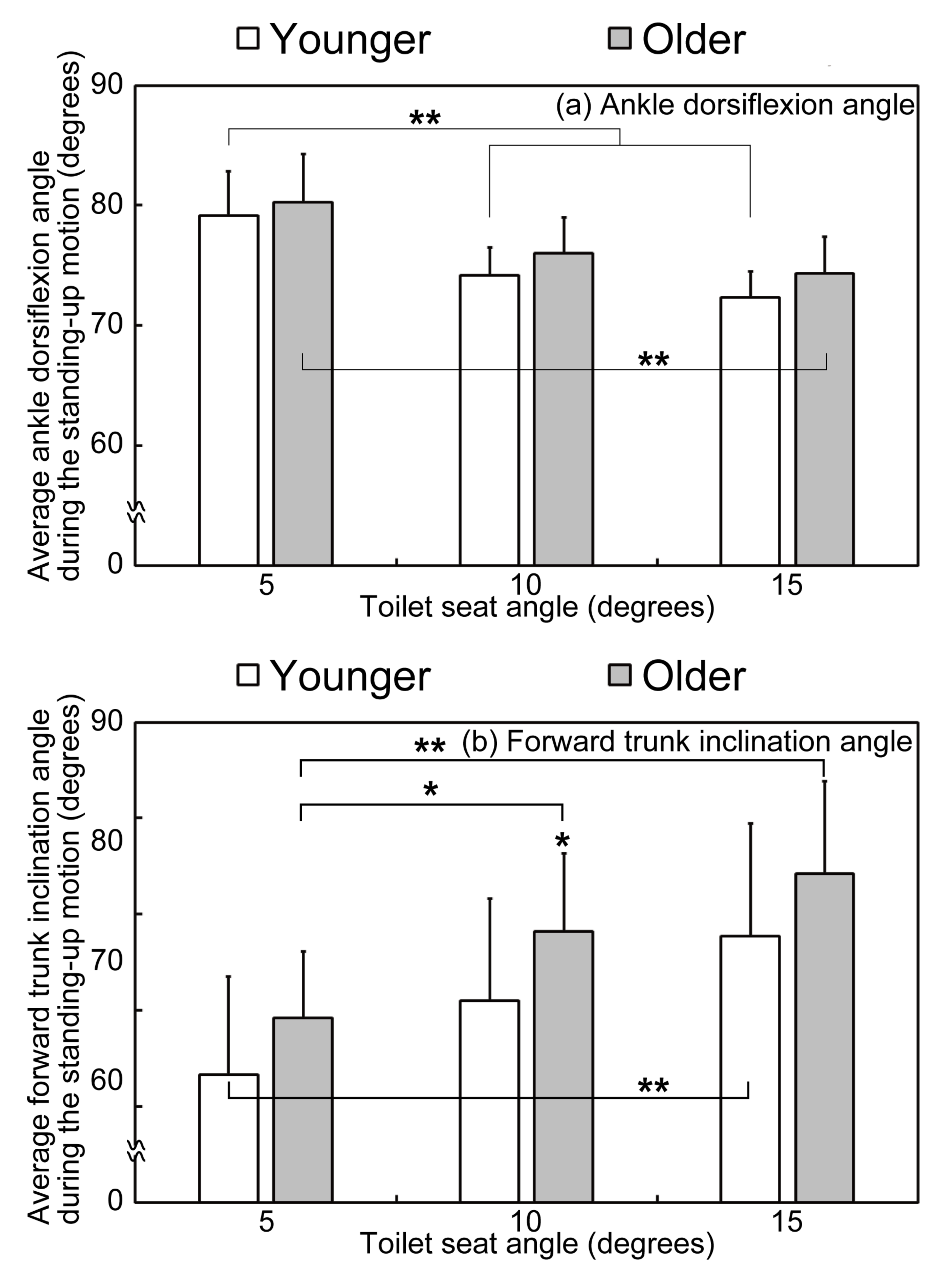
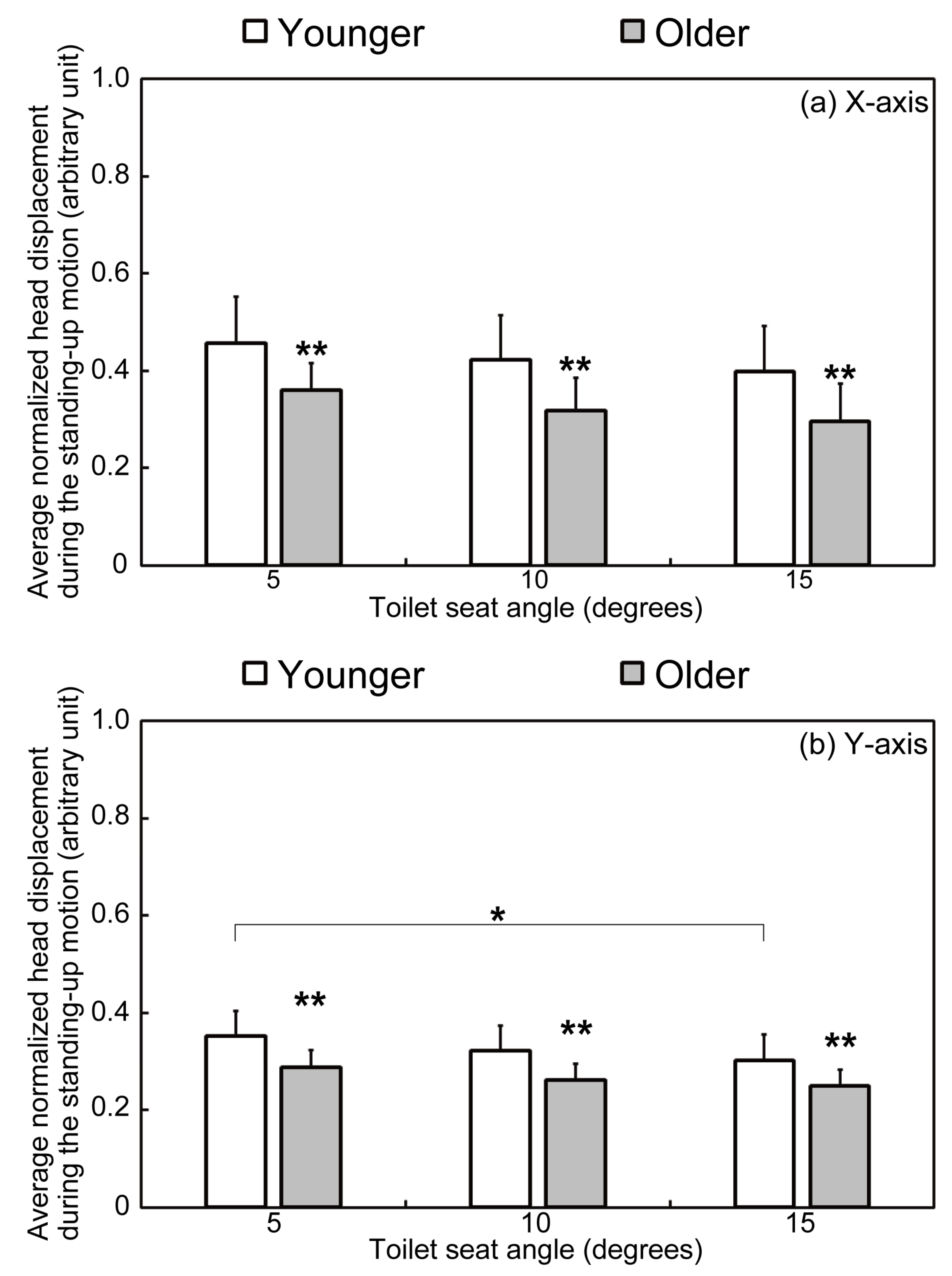



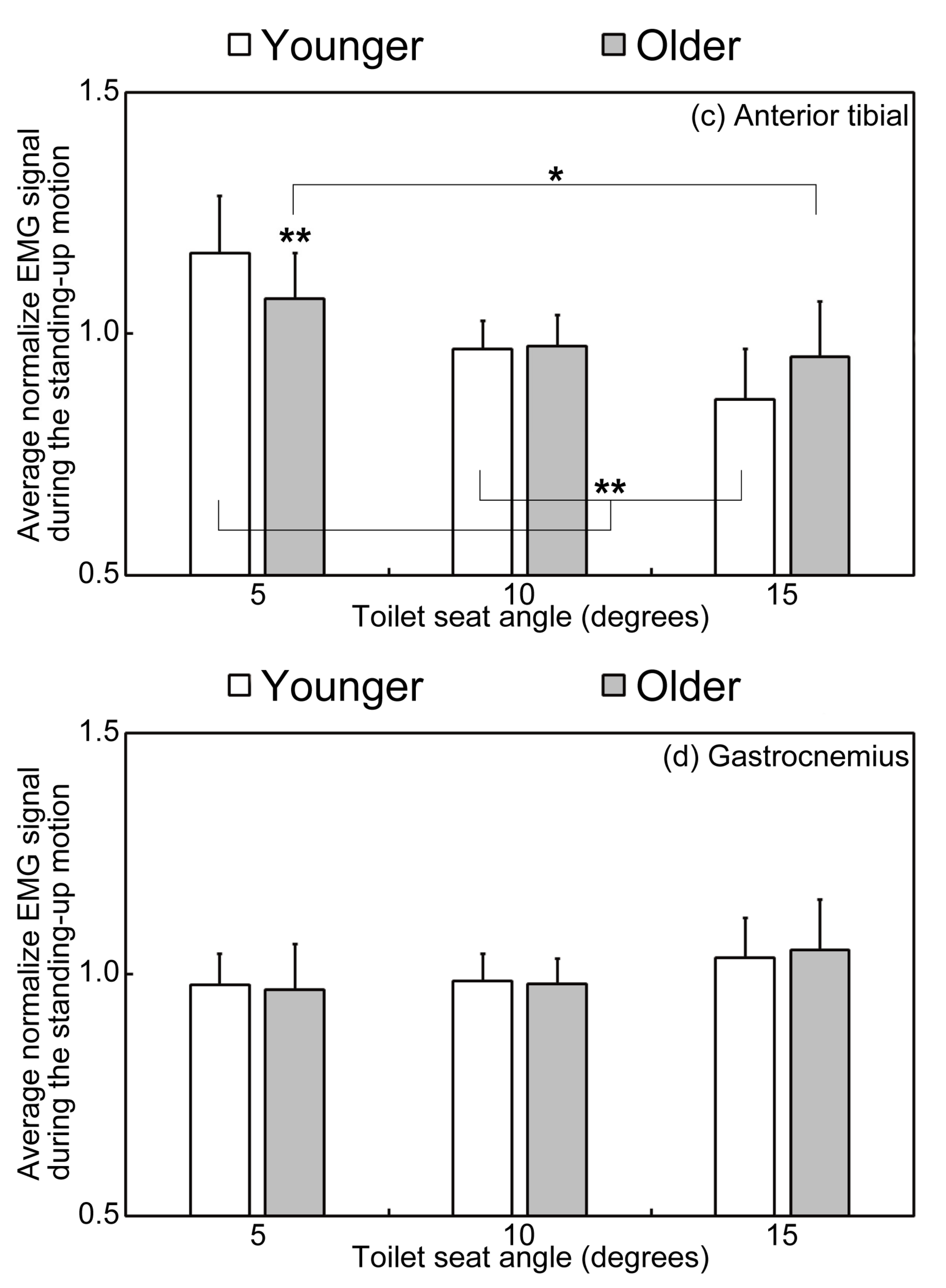
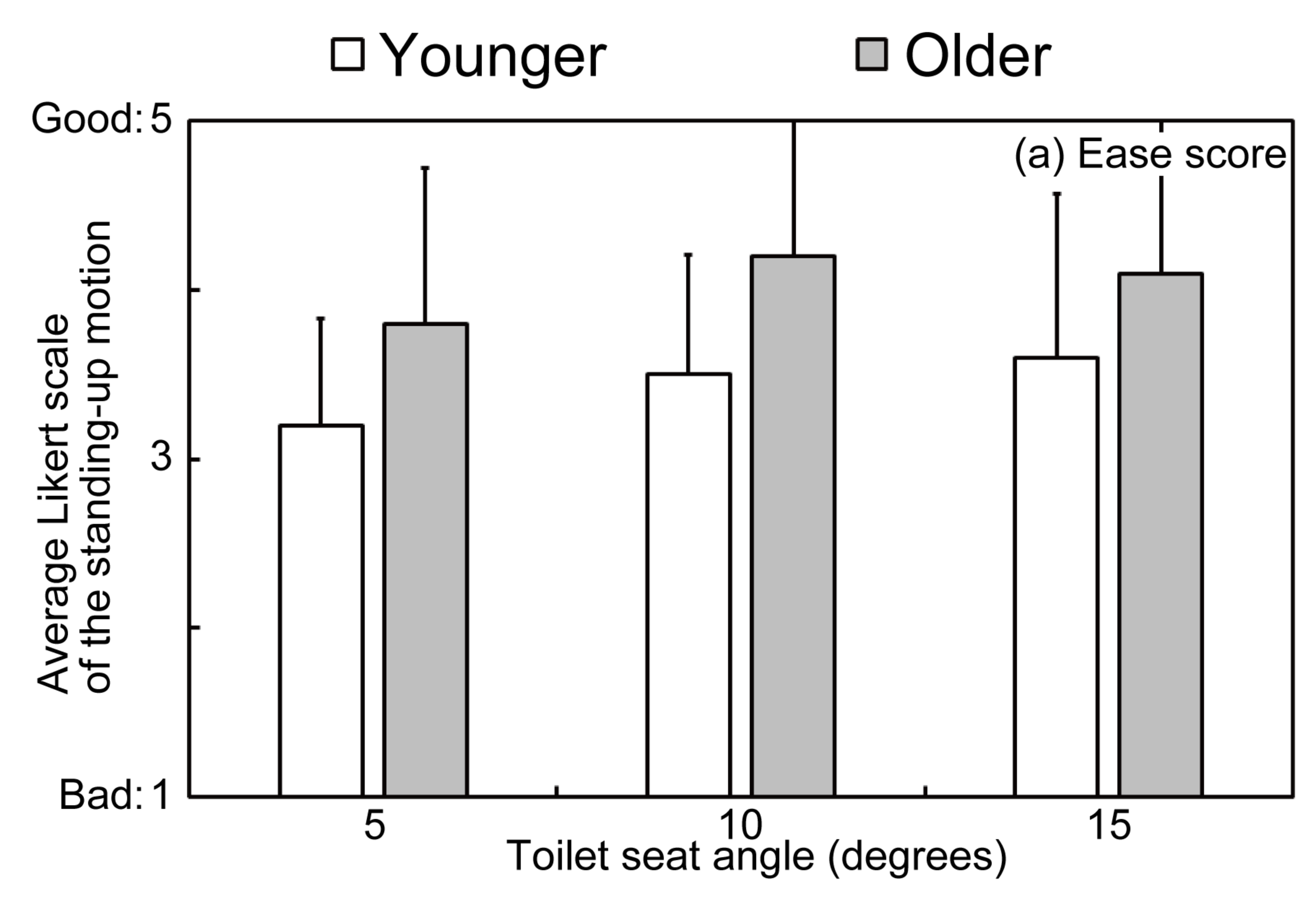
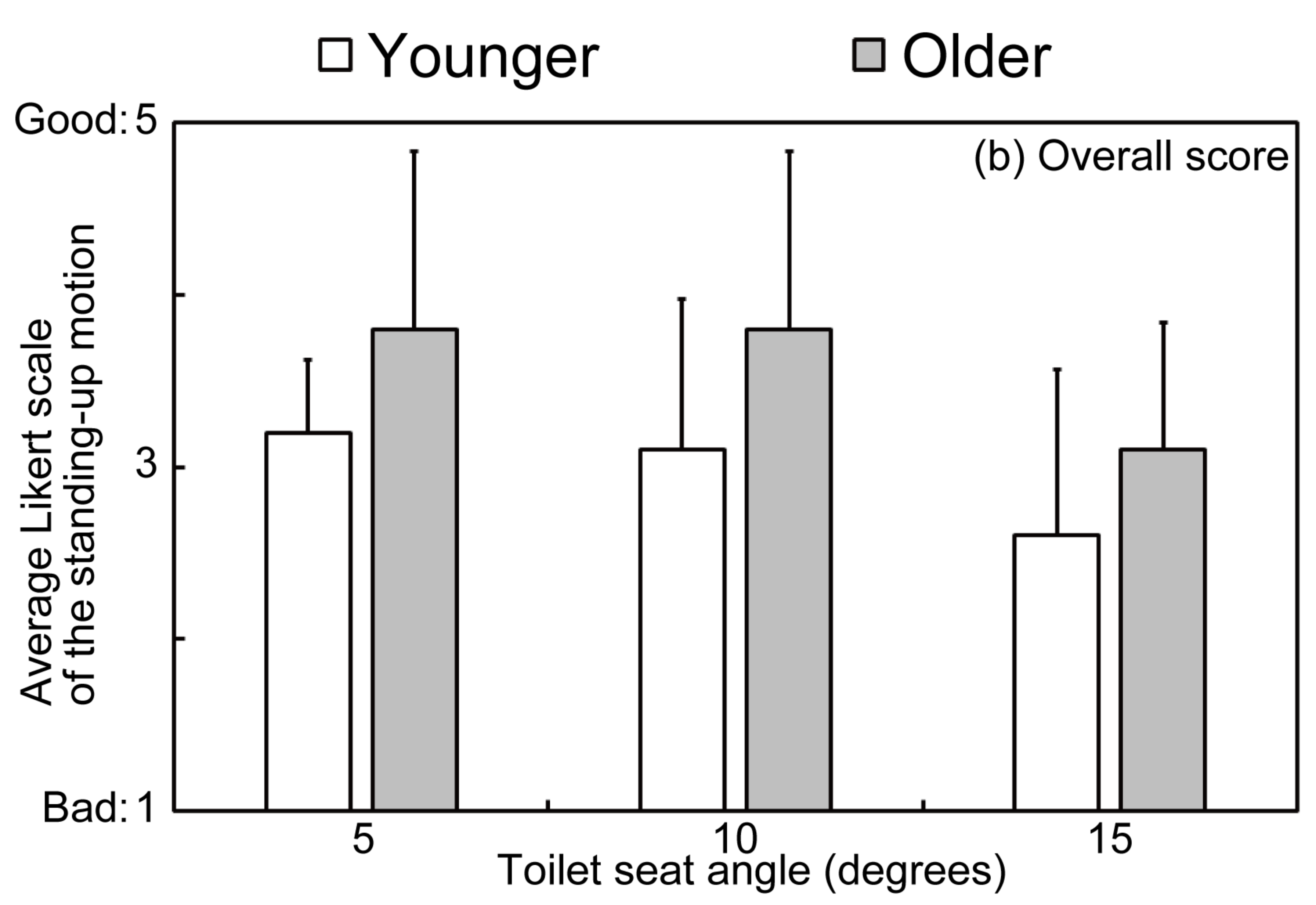
| Total | Younger | Older | |||
|---|---|---|---|---|---|
| Male | Female | Male | Female | ||
| n = 20 | n = 5 | n = 5 | n = 5 | n = 5 | |
| Age (years) | 41.2 ± 14.5 | 42.2 ± 12.8 | 71.4 ± 1.7 | 71.8 ± 2.0 | |
| Body height (cm) | 170.8 ± 4.0 | 159.4 ± 5.3 | 168.7 ± 4.0 | 149.6 ± 5.8 | |
| Body weight (kg) | 62.5 ± 4.2 | 55.9 ± 6.5 | 65.2 ± 1.6 | 54.3 ± 4.8 | |
| Measurement times for each person | |||||
| Total | Toilet seat angle | ||||
| 5° | 10° | 15° | |||
| Objective data | |||||
| Motion | 75 | 25 | 25 | 25 | |
| COP | 75 | 25 | 25 | 25 | |
| EMG | 75 | 25 | 25 | 25 | |
| Subjective data | |||||
| Score | 3 | 1 | 1 | 1 | |
| Toilet Seat Angle | ||||
|---|---|---|---|---|
| 5° | 10° | 15° | ||
| Objective data | ||||
| Motion | Ankle dorsiflexion angle | |||
| Forward trunk inclination angle | * | |||
| Forward–backward head motion | ** | ** | ** | |
| Up–down head motion | ** | ** | ** | |
| COP | Peak-to-peak displacement in the X-axis | |||
| Peak-to-peak displacement in the Z-axis | * | * | ||
| EMG | Erector spinae | ** | ||
| Rectus femoris | ||||
| Tibialis anterior | ** | |||
| Gastrocnemius | ||||
| Subjective data | ||||
| Score | Ease score | |||
| Overall score | ||||
Publisher’s Note: MDPI stays neutral with regard to jurisdictional claims in published maps and institutional affiliations. |
© 2021 by the authors. Licensee MDPI, Basel, Switzerland. This article is an open access article distributed under the terms and conditions of the Creative Commons Attribution (CC BY) license (http://creativecommons.org/licenses/by/4.0/).
Share and Cite
Chikai, M.; Ozawa, E.; Endo, H.; Ino, S. Evaluation of Standing-Up Motion from a Forward-Sloping Toilet Seat for Older People. Appl. Sci. 2021, 11, 1368. https://doi.org/10.3390/app11041368
Chikai M, Ozawa E, Endo H, Ino S. Evaluation of Standing-Up Motion from a Forward-Sloping Toilet Seat for Older People. Applied Sciences. 2021; 11(4):1368. https://doi.org/10.3390/app11041368
Chicago/Turabian StyleChikai, Manabu, Emi Ozawa, Hiroshi Endo, and Shuichi Ino. 2021. "Evaluation of Standing-Up Motion from a Forward-Sloping Toilet Seat for Older People" Applied Sciences 11, no. 4: 1368. https://doi.org/10.3390/app11041368
APA StyleChikai, M., Ozawa, E., Endo, H., & Ino, S. (2021). Evaluation of Standing-Up Motion from a Forward-Sloping Toilet Seat for Older People. Applied Sciences, 11(4), 1368. https://doi.org/10.3390/app11041368






